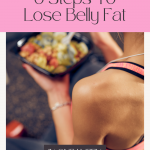
Gaining a slimmer waistline is a common fitness goal for many of us. If you’re looking to shed belly fat and achieve a flat stomach, incorporating effective exercises into your routine is crucial. In this article, I will share our 6 simple steps to help you lose belly fat fast and get closer to your fitness goals.
It’s important to note that spot reduction is not possible, and losing belly fat requires an overall approach to weight loss. By adopting healthy habits and committing to a consistent exercise routine, you can start seeing results in no time.
Key Takeaways:
- Include cardiovascular exercises like walking or jogging to burn calories and promote overall weight loss.
- Incorporate strength training exercises to build lean muscle mass, increase metabolic rate, and burn more calories.
- Track your caloric intake to create a calorie deficit and ensure you’re consuming fewer calories than you burn.
- Increase your fiber intake to promote feelings of fullness and aid in weight loss. Opt for whole grains, fruits, vegetables, and legumes.
- Orient your diet towards healthy fats like avocado, nuts, olive oil, and fatty fish to promote satiety and support overall weight loss.
step 1 – Set Realistic Expectations
When it comes to losing belly fat, it’s important to set realistic expectations. While we all want quick results, rapid fat loss is not sustainable and can often lead to disappointment and frustration. Instead, it’s crucial to focus on long-term changes that will yield lasting results.
Setting small, achievable goals is key to staying motivated on your journey to a flat stomach. By breaking down your ultimate goal into smaller milestones, you can track your progress and celebrate each accomplishment along the way.
Remember, losing belly fat takes time and consistency. It’s not just about doing a few exercises here and there. It requires a holistic approach that includes a balanced diet, regular exercise, and lifestyle modifications. By setting realistic expectations and committing to a healthy lifestyle, you’ll be on your way to achieving your desired results.
Why Quick Fixes Won’t Work
“Losing belly fat quickly is tempting, but it’s important to understand that sustainable weight loss doesn’t happen overnight. Crash diets or excessive exercise can lead to muscle loss, nutrient deficiencies, and a slowed down metabolism.”
– Dr. Sarah Johnson, Nutrition Expert
https://www.forbes.com/health/weight-loss/how-to-lose-weight-fast/
While it may be tempting to try trendy diets or extreme exercise programs, it’s crucial to remember that these quick fixes often do more harm than good. They can disrupt your body’s natural balance and lead to undesirable side effects.
Instead, focus on making small, consistent changes that you can maintain in the long term. This will not only help you lose belly fat but also improve your overall health and well-being.
step 2 – figure out what are The Best Exercises for Belly Fat Reduction
When it comes to exercise, there is no single “best” exercise for belly fat reduction. The key is to incorporate a variety of exercises that target different muscles and promote overall fat loss.
- Aerobic exercises: Activities like running, cycling, swimming, or dancing are great for burning calories and boosting your metabolism.
- Strength training: Including exercises that target the abdominal muscles, such as crunches, planks, and Russian twists, can help tone and strengthen your core.
- High-intensity interval training (HIIT): HIIT workouts involve short bursts of intense exercise followed by brief recovery periods. These workouts are effective for burning calories and improving cardiovascular fitness.
Remember to consult with a fitness professional before starting a new exercise program. They can provide personalized guidance and ensure you’re performing exercises correctly to avoid injury.
Include Cardiovascular Exercises

When it comes to targeting belly fat, cardiovascular exercises are your best friend. Activities like walking, jogging, or cycling are effective in burning calories and promoting overall weight loss. By incorporating these exercises into your routine, you’ll be one step closer to shedding that stubborn belly fat.
To maximize your results, aim for at least 150 minutes of moderate-intensity cardio per week. This can be achieved by dedicating 30 minutes of exercise on five days of the week. By maintaining a consistent cardio routine, you’ll increase your calorie burn, which in turn contributes to reducing belly fat.
Cardiovascular exercises not only help you burn calories but also provide numerous health benefits. They improve cardiovascular health, boost overall endurance, and enhance mood. As a bonus, these exercises can be tailored to fit your preferences and fitness level.
Incorporate Strength Training

To effectively lose belly fat and achieve a toned stomach, it’s important to incorporate strength training exercises into your fitness routine. Strength training helps build lean muscle mass, which can increase your metabolic rate and burn more calories even at rest. By targeting the abdominal muscles with exercises like crunches and planks, as well as engaging in full-body strength training exercises like squats and deadlifts, you can optimize fat loss and achieve a sculpted midsection.
When performing strength training exercises, it’s important to maintain proper form and gradually increase the intensity and weight as your fitness level improves. Start with lighter weights and focus on performing each exercise with control and precision. Gradually increase the weight and repetitions as you build strength and confidence.
Incorporate HIIT

When it comes to torching calories and achieving a high-intensity workout, High-Intensity Interval Training (HIIT) takes the spotlight. HIIT workouts involve short bursts of intense exercise followed by brief periods of rest or lower-intensity activity. This dynamic approach not only maximizes calorie burn during the workout but also keeps your metabolism elevated afterward, contributing to fat loss.
To effectively incorporate HIIT into your routine, aim for at least 20-30 minutes of HIIT sessions, 2-3 times a week. These sessions can include exercises like sprinting, jumping jacks, burpees, or mountain climbers, performed at maximum effort during the high-intensity intervals. The intermittent nature of HIIT keeps your body guessing and ensures a challenging workout that engages various muscle groups.
To optimize the benefits of HIIT, customize your routine based on your fitness level and preferences. You can experiment with different exercises and work-to-rest ratios to find what works best for you. As with any exercise program, it’s crucial to start gradually and progressively increase the intensity to avoid injury and accommodate your evolving fitness level.
Incorporating HIIT into your fitness regimen not only aids in burning calories but also offers additional perks. It enhances cardiovascular health, boosts metabolism, and improves insulin sensitivity. Plus, the versatility of HIIT allows you to tailor your workouts to fit your schedule and goals, making it a time-efficient and effective option for those looking to shed fat and improve overall fitness.
Targeted Abdominal Exercises
Targeted abdominal exercises can help strengthen and tone your tummy muscles. Include exercises like:
- Crunches
- Planks
- Reverse crunches
- Russian twists
- Mountain climbers
Perform these exercises 2-3 times a week, allowing your muscles to rest and recover between sessions. Combine them with other full-body strength training exercises for a well-rounded workout routine.
Full-Body Strength Training
In addition to targeting the abdominal muscles, full-body strength training exercises are essential for overall fat loss and muscle development. Incorporate exercises like:
- Squats
- Deadlifts
- Lunges
- Push-ups
- Rows
These exercises engage multiple muscle groups and help boost your metabolism. Aim to perform full-body strength training exercises 2-3 times a week, alternating between different exercises to ensure proper muscle stimulation and prevent boredom.
| Exercise | Repetitions | Sets |
|---|---|---|
| Squats | 12-15 | 3 |
| Deadlifts | 10-12 | 3 |
| Lunges | 10-12 (each leg) | 3 |
| Push-ups | 10-15 | 3 |
| Rows | 10-12 | 3 |
Remember to warm up before starting any strength training routine and cool down with stretching exercises afterwards to prevent injury and promote muscle recovery. Listen to your body and choose weights and exercises that challenge you without causing strain or pain.
Strength training not only helps you lose belly fat, but it also provides numerous other health benefits such as improved posture, increased bone density, and enhanced overall strength and endurance. By incorporating targeted abdominal exercises and full-body strength training into your fitness routine, you’ll be on your way to achieving a flat stomach and a stronger, healthier body.
step 3 – Track Your Caloric Intake
One of the fundamental aspects of weight loss is creating a calorie deficit. By tracking your caloric intake, you can ensure that you are consuming fewer calories than you burn. This allows your body to tap into its fat stores for energy, leading to a reduction in abdominal fat.
To effectively track your caloric intake, consider using a weight loss app or keeping a food journal. These tools help you stay mindful of the calories you consume and make informed choices about your diet. They allow you to track not only the calories in your meals but also the calories you burn through exercise, providing a comprehensive overview of your energy balance.
When tracking your caloric intake, it’s important to focus on nutrient-dense, whole foods that support your weight loss goals. This includes vegetables, lean proteins, whole grains, and healthy fats. Avoiding highly processed foods and beverages that are high in added sugars and unhealthy fats can help in achieving a flat stomach.
Remember, tracking your caloric intake is just one tool in your weight loss journey. It’s crucial to combine it with other exercise tips and lifestyle changes for optimal results. By creating a calorie deficit through mindful eating and regular exercise, you can effectively reduce abdominal fat and work towards a flat stomach.
step 4 – Fix your diet
Fixing your diet is crucial for fast and effective weight loss for several reasons. Firstly, diet plays a significant role in determining your overall calorie intake. Consuming fewer calories than your body needs is essential for creating a calorie deficit, which is the fundamental principle behind weight loss. Even with intense exercise, it’s challenging to out-exercise a poor diet.
Secondly, a balanced and nutrient-dense diet provides your body with the essential vitamins, minerals, and nutrients it needs to function optimally. This not only supports your overall health but also ensures that you’re getting the right nutrients for sustained energy levels, muscle function, and metabolic processes.
Furthermore, focusing on a healthy diet helps regulate hormones and insulin levels, which are critical factors in fat storage and metabolism. A diet rich in whole foods, lean proteins, fruits, vegetables, and whole grains can help stabilize blood sugar levels, reducing cravings and promoting a feeling of fullness.
In summary, fixing your diet is important for weight loss because it directly influences your calorie intake, provides essential nutrients for overall health, and helps regulate hormonal and metabolic processes. Combining a healthy diet with regular exercise enhances your chances of achieving and maintaining sustainable weight loss.
Increase Fiber Intake
Incorporating fiber-rich foods into your diet can have a significant impact on belly fat reduction. Not only do these foods help promote feelings of fullness, but they also aid in weight loss by regulating digestion. When it comes to incorporating fiber into your diet, focus on including whole grains, fruits, vegetables, and legumes.
Aim for at least 25 grams of fiber per day
Aim to consume at least 25 grams of fiber per day. This ensures that you’re getting enough fiber to support your weight loss efforts and overall health. Here are some fiber-rich foods you can include in your diet:
- Whole grains, such as oats, quinoa, and brown rice
- Fruits, such as berries, apples, and oranges
- Vegetables, such as broccoli, spinach, and Brussels sprouts
- Legumes, such as chickpeas, lentils, and black beans
By incorporating these fiber-rich foods into your diet, you’ll not only support your belly fat reduction goals, but also improve your overall health and well-being.
Benefits of Increasing Fiber Intake
Increasing your fiber intake offers several benefits for belly fat reduction and overall health:
- Fiber helps promote feelings of fullness, which can prevent overeating and aid in weight loss.
- Fiber-rich foods have a low energy density, meaning they provide fewer calories for the same volume of food, helping you maintain a calorie deficit.
- Fiber aids in digestion by promoting regular bowel movements, and reducing bloating and discomfort.
- High-fiber foods have a slower digestion rate, resulting in better blood sugar control and reduced insulin spikes.
- Fiber promotes a healthy gut microbiome, which is associated with improved weight management and reduced belly fat.
Incorporating fiber into your diet is a simple and effective strategy for belly fat reduction. By choosing fiber-rich foods and aiming for the recommended daily intake, you can support your weight loss goals and improve your overall health.
Opt for Healthy Fats
Incorporating healthy fats into your diet can be beneficial for achieving a flat stomach (Hyman, M. (2016). Contrary to popular belief, not all fats are bad for you. In fact, some fats are essential for your body’s optimal functioning and can even support your weight loss goals. When selecting fats for your meals, opt for sources that are rich in nutrients and promote satiety.
Include foods like avocados, nuts, olive oil, and fatty fish such as salmon or tuna. These options provide valuable nutrients like omega-3 fatty acids, which have been shown to reduce inflammation and support heart health. Additionally, healthy fats can help you feel satisfied after your meals, reducing the desire to snack or overeat. Incorporating these fats into your diet can help curb cravings and promote overall weight loss.
Remember, moderation is key when consuming fats. While healthy fats offer numerous benefits, they are still calorie-dense, so be mindful of portion sizes. Aim to include a variety of healthy fats in your meals while maintaining balanced overall nutrition.
By including these healthy fats in your diet, you can enhance your efforts to achieve a flat stomach. Remember, exercise and a well-rounded approach to nutrition are crucial in reaching your fitness goals.
Prioritize Protein Intake
When it comes to reducing abdominal fat and achieving your flat stomach goals, prioritizing protein intake is key. Consuming adequate amounts of protein is essential for preserving muscle mass and promoting fat loss.
Include lean protein sources like chicken, fish, tofu, and legumes in your meals. These protein-rich foods not only provide essential nutrients but also help keep you full and satisfied, reducing the chances of overeating.
Protein also plays a crucial role in supporting muscle growth and repair. By including protein in your diet, you can ensure that your body has the necessary building blocks to maintain and build lean muscle mass.
To further enhance the benefits of protein intake, pair it with regular exercise to reduce abdominal fat. Combining protein-rich meals with belly fat loss exercises can optimize your results and help you achieve a toned and flat stomach.
“Protein is the foundation for building and maintaining a strong, lean body. By incorporating protein-rich foods into your diet, you can support your weight loss efforts and achieve a trimmer midsection.” – Fitness Expert
The Importance of Protein for Fat Loss
Protein is known for its thermogenic effect, meaning that it requires more energy to digest compared to fats or carbohydrates. This increased energy expenditure can help boost your metabolism and contribute to fat burning (Moon, J., & Koh, G. 2020).
- Protein-rich foods can help control hunger and cravings, making it easier to stick to your calorie goals.
- Protein supports muscle growth and repair, helping you maintain a toned appearance as you lose fat.
- Protein can help regulate blood sugar levels and improve insulin sensitivity, reducing the risk of weight gain and metabolic disorders.
Incorporating protein into each meal can be as simple as adding grilled chicken to your salad, including fish in your stir-fry, or enjoying a plant-based protein shake as a snack.
Remember to consult with a healthcare professional or registered dietitian for personalized advice on protein intake and to ensure it aligns with your specific nutritional needs.
By prioritizing protein intake, you can optimize your efforts to reduce abdominal fat and achieve a flat stomach. Combine it with belly fat loss exercises and make consistent, healthy choices to reach your weight loss goals.
step 5 – Manage your Stress Levels

According to research by Geiker et al. (2017), stress can have a significant impact on weight gain, especially in the abdominal area. When our bodies are under stress, they release cortisol, a hormone that can lead to increased fat storage.
To combat stress and its effects on belly fat, it’s crucial to find healthy ways to manage stress. Here are some quick and effective strategies:
- Practice Yoga: Engaging in yoga can help to reduce stress levels and promote relaxation. It combines physical movement and breathing techniques, which have been shown to lower cortisol levels. Incorporate a yoga practice into your routine a few times a week to reap its stress-reducing benefits.
- Meditate Daily: Meditation is a powerful tool for managing stress. Taking just a few minutes each day to sit quietly and focus on your breath can help calm your mind, reduce cortisol levels, and alleviate stress-related belly fat. Start with a short meditation practice and gradually increase the duration as you become more comfortable.
- Engage in Hobbies: Finding enjoyable activities can be a great way to reduce stress. Whether it’s painting, gardening, playing an instrument, or dancing, hobbies provide an outlet for relaxation and help distract from everyday worries. Set aside regular time to indulge in activities that bring you joy and help you unwind.
Remember, managing stress is not only beneficial for reducing belly fat, but also for your overall well-being. By incorporating stress-relieving practices into your routine, you can create a healthier and happier lifestyle.
The Impact of Stress on Belly Fat
“Stress can lead to weight gain and increased belly fat. When we’re stressed, our bodies release cortisol, a hormone that promotes fat storage. Managing stress through practices like yoga, meditation, and engaging in hobbies can help reduce cortisol levels and support belly fat loss.”
| Ways to Manage Stress Levels | Benefits |
|---|---|
| Practice Yoga | Reduces cortisol levels and promotes relaxation |
| Meditate Daily | Calms the mind and lowers stress-related cortisol levels |
| Engage in Hobbies | Provides an outlet for relaxation and distraction from stress |
Get Enough Sleep
Adequate sleep is crucial for both weight loss and overall health. When you don’t get enough sleep, it can disrupt your hormone levels, increase cravings, and hinder your efforts to lose belly fat. That’s why it’s important to prioritize quality sleep as part of your weight loss journey.
Research has shown that lack of sleep can lead to weight gain and an increased risk of obesity. When you’re sleep-deprived, your body produces more ghrelin, the hormone that stimulates hunger, while reducing levels of leptin, the hormone that signals fullness. This hormonal imbalance can result in excessive food cravings, especially for high-calorie, sugary foods.
Additionally, inadequate sleep can negatively impact your metabolism. It can disrupt the regulation of glucose and insulin in your body, making it harder to maintain stable blood sugar levels. This can lead to insulin resistance, a condition associated with weight gain and increased belly fat.
To support your weight loss goals, aim for 7-9 hours of quality sleep each night. Here are some tips to improve your sleep quality:
- Create a bedtime routine: Establish a consistent bedtime routine to signal to your body that it’s time to wind down and prepare for sleep. This may include activities such as reading a book, taking a warm bath, or practicing relaxation techniques.
- Avoid stimulants: Limit your consumption of caffeine and avoid it altogether in the evening. Caffeine can interfere with your ability to fall asleep and stay asleep.
- Create a sleep-friendly environment: Make your bedroom a peaceful and comfortable sanctuary. Keep the room cool, dark, and quiet. Consider using earplugs, an eye mask, or white noise machines to create an optimal sleep environment.
- Avoid electronic devices before bed: The blue light emitted by smartphones, tablets, and computers can disrupt your sleep-wake cycle. Try to avoid using these devices at least an hour before bed.
- Manage stress: Stress can interfere with sleep. Practicing stress management techniques, such as meditation or deep breathing exercises, can help calm your mind and promote better sleep.
Incorporating these sleep hygiene practices into your daily routine can significantly improve the quality and duration of your sleep. By getting enough rest, you’ll not only support your weight loss efforts but also enhance your overall well-being.
step 6 – Stay Consistent and Patient
Consistency is key when it comes to losing belly fat. It is important to stay committed to your exercise routine and healthy eating habits over time to see significant results. Quick ways to lose belly fat with exercise may seem appealing, but sustainable and long-term changes are crucial for lasting success.
Effective exercises for belly fat can help you tone and strengthen your abdominal muscles. However, it’s essential to remember that spot reduction is not possible, and losing weight overall is necessary to reduce belly fat.
Weight loss takes time, and it’s important not to get discouraged if you don’t see immediate changes. Rome wasn’t built in a day, and the same applies to your fitness journey. It requires patience, perseverance, and a consistent effort to achieve your goals.
Staying motivated is key to success. Set achievable milestones along the way to track your progress and celebrate your achievements. By focusing on your ultimate goal and embracing a positive mindset, you can stay on track and continue making progress towards losing belly fat and achieving a flat stomach.
Remember, every effort counts. Stay consistent, be patient with yourself, and trust the process. The results will come!
Take a look at the table below for a summary of the key points to remember in this article:
| Key Takeaways: |
|---|
| Consistency is key |
| Focus on long-term changes |
| Set achievable goals |
| Stay motivated and patient |
Conclusion
Achieving a flat stomach requires a combination of exercise, proper nutrition, and lifestyle changes. By incorporating these exercise tips for a flat stomach and making sustainable choices, you can work towards reducing belly fat and achieving your desired results. Remember that losing belly fat takes time and patience, so stay consistent with your efforts.
It’s important to consult with a healthcare professional before starting any new exercise or diet regimen. They can provide personalized advice and ensure that you’re taking the right approach for your specific needs and health conditions.
With a well-rounded approach that includes cardiovascular exercises, strength training, and a healthy diet, you can see significant improvements in your belly fat loss journey. Stay motivated, stay dedicated, and soon enough, you’ll be on your way to a flatter stomach and a healthier you.
FAQ
Can I lose belly fat quickly with exercise alone?
While exercise is important for losing belly fat, it cannot be achieved through spot reduction. It’s important to adopt healthy habits and a consistent exercise routine along with a well-rounded approach to see results. Losing weight overall will result in a reduction in belly fat.
What should my expectations be when it comes to losing belly fat?
It’s important to have realistic expectations. Rapid fat loss is not sustainable, so it’s important to focus on long-term changes for lasting results. Setting small, achievable goals can help keep you motivated on your journey to a flat stomach.
How can I create a calorie deficit to promote belly fat loss?
One of the fundamental aspects of weight loss is creating a calorie deficit. This can be achieved by tracking your caloric intake and ensuring that you are consuming fewer calories than you burn. You can use a weight loss app or simply keep a record of the calories you consume and the calories you burn through exercise.
How can increasing fiber intake help with belly fat loss?
Incorporating fiber-rich foods into your diet can help promote feelings of fullness and aid in weight loss. Foods such as whole grains, fruits, vegetables, and legumes are high in fiber and can help regulate digestion. Aim for at least 25 grams of fiber per day to support your weight loss efforts.
What role do cardiovascular exercises play in belly fat reduction?
Cardiovascular exercises, such as walking or jogging, can help burn calories and promote overall weight loss. Aim for at least 150 minutes of moderate-intensity cardio per week. This can help increase your calorie burn and contribute to reducing belly fat.
How does strength training contribute to belly fat reduction?
Strength training is crucial for building lean muscle mass, which can help increase your metabolic rate and burn more calories. Include exercises that target the abdominal muscles, such as crunches and planks, as well as full-body strength training exercises like squats and deadlifts.
Are there specific fats that can help with belly fat loss?
Including healthy fats in your diet, such as those found in avocado, nuts, olive oil, and fatty fish, can help promote satiety and support overall weight loss. These fats provide essential nutrients while helping you stay satisfied and curb cravings.
Why is protein intake important for reducing belly fat?
Consuming adequate protein is essential for preserving muscle mass and promoting fat loss. Include lean protein sources like chicken, fish, tofu, and legumes in your meals. Protein-rich foods can help keep you full and support muscle growth and repair.
Can stress impact belly fat and how can I manage it?
Stress can contribute to weight gain, especially in the abdominal area. Find healthy ways to manage stress, such as practicing yoga, meditation, or engaging in hobbies. Taking care of your mental well-being can have a positive impact on your physical health.
How does sleep affect belly fat and weight loss?
Adequate sleep is important for weight loss and overall health. Lack of sleep can disrupt hormone levels, increase cravings, and hinder weight loss efforts. Aim for 7-9 hours of quality sleep each night to support your weight loss goals.
What is the key to success in losing belly fat?
Consistency is key when it comes to losing belly fat. Stick to your exercise routine and healthy eating habits over time to see results. Weight loss takes time, so be patient and don’t get discouraged if you don’t see immediate changes. Stay motivated and focused on your ultimate goal.
Can I achieve a flat stomach by following these exercise hacks?
Achieving a flat stomach requires a combination of exercise, proper nutrition, and lifestyle changes. By incorporating these exercise hacks and making sustainable choices, you can work towards reducing belly fat and achieving a flat stomach. Remember to consult with a healthcare professional before starting any new exercise or diet regimen.
Citations and Resources used
- Hyman, M. (2016). Eat fat, get thin: Why the fat we eat is the key to sustained weight loss and vibrant health. Hachette UK.
- Moon, J., & Koh, G. (2020). Clinical Evidence and Mechanisms of High-Protein Diet-Induced Weight Loss. Journal of Obesity and Metabolic Syndrome, 29(3), 166–173. https://doi.org/10.7570/jomes20028
Hey there, I’m Luke, and I’ve been immersed in the fitness world since 2007. From gym floors to running my own personal training business, I’ve seen it all. My journey led me to study Sports Science at university, where I deepened my understanding of the science behind exercise.
One thing that truly lights my fire? High-Intensity Interval Training (HIIT). It’s not just a workout; it’s a game-changer. I’ve used HIIT to help countless men and women shed weight and transform their lives for the better.
Through my personal training business, I’ve witnessed the incredible impact of HIIT on both physical and mental well-being. It’s not just about getting fitter; it’s about feeling stronger, more confident, and more resilient.
Join me on this journey to a healthier, happier you. Let’s crush those goals together!




